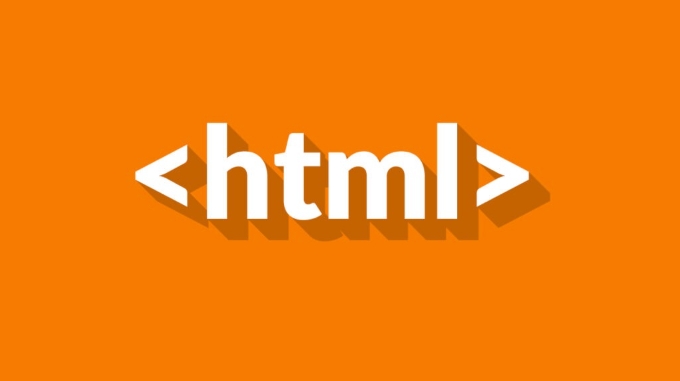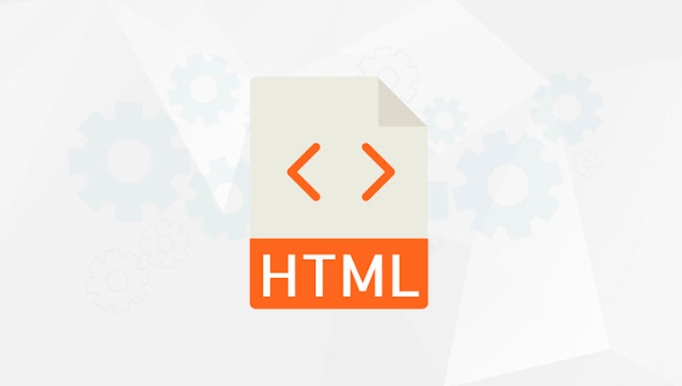What is HTML5 Drag and Drop?
HTML5 Drag and Drop allows users to drag web page elements to a new location through the mouse. 1. Set draggable="true" to make the elements draggable; 2. Use dragstart, dragover, drop and other events to handle drag and drop; 3. Call preventDefault() in dragover to allow placement; 4. Use dataTransfer object to pass data; 5. Note that the mobile terminal needs additional processing. This function is built into modern browsers and is suitable for scenes such as list sorting, file uploading, etc., making the interaction more intuitive.

HTML5 Drag and Drop is a feature that allows users to grab elements on a webpage and drag them to another location using the mouse. It enables independent, interactive behaviors—like moving files, reordering lists, or placing items into designed areas—without needing third-party libraries or complex JavaScript.

This functionality is built directly into modern browsers through the HTML5 Drag and Drop API , which provides events and methods to control what happens during drag operations.
How It Works
The process involves two main parts:

- The draggable element – the item being moved.
- The drop zone – the target where the item is released.
You can make any HTML element draggable by setting the draggable="true" attribute, then use JavaScript to handle the drag-and-drop events.
Key Drag and Drop Events
Here are the core events used in the API:

-
dragstart– fired when the user starts dragging an element. -
drag– fired continuously while the element is being dragged. -
dragend– fired when the dragging ends (eg, mouse released). -
dragenter– fired when the dragged element enters a valid drop target. -
dragover– fired continuously while the dragged element is over a drop target (you usuallypreventDefault()here to allow drops). -
dragleave– fired when the dragged element leaves the drop target. -
drop– fired when the user releases the dragged element over a valid drop zone.
Basic Example
<div id="dragElem" draggable="true" style="width:100px; height:100px; background:blue;">
Drag me!
</div>
<div id="dropZone" style="width:200px; height:200px; background:gray; margin-top:20px;">
Drop here
</div>
<script>
const dragElem = document.getElementById('dragElem');
const dropZone = document.getElementById('dropZone');
dragElem.addEventListener('dragstart', (e) => {
e.dataTransfer.setData('text/plain', dragElem.id);
});
dropZone.addEventListener('dragover', (e) => {
e.preventDefault(); // Required to allow drop
});
dropZone.addEventListener('drop', (e) => {
e.preventDefault();
const data = e.dataTransfer.getData('text/plain');
const draggedElement = document.getElementById(data);
dropZone.appendChild(draggedElement);
});
</script>Common Use Cases
- Reordering list items (eg, task lists)
- Uploading files by dragging them into a browser
- Building dashboards where widgets can be moved
- Game interfaces (eg, puzzle pieces, card games)
Things to Keep in Mind
- By default, text, images, and links are draggable in most browsers.
- You must call
e.preventDefault()indragoveranddropto allow dropping. - The
dataTransferobject is used to pass data (like IDs or text) between drag and drop events. - Mobile support is limited—native HTML5 drag and drop doesn't work well on touch devices without polyfills or special handling.
Basically, HTML5 Drag and Drop makes web apps feel more dynamic and user-friendly, and it's surprisingly simple to implement for basic tasks.
The above is the detailed content of What is HTML5 Drag and Drop?. For more information, please follow other related articles on the PHP Chinese website!

Hot AI Tools

Undress AI Tool
Undress images for free

Undresser.AI Undress
AI-powered app for creating realistic nude photos

AI Clothes Remover
Online AI tool for removing clothes from photos.

Clothoff.io
AI clothes remover

Video Face Swap
Swap faces in any video effortlessly with our completely free AI face swap tool!

Hot Article

Hot Tools

Notepad++7.3.1
Easy-to-use and free code editor

SublimeText3 Chinese version
Chinese version, very easy to use

Zend Studio 13.0.1
Powerful PHP integrated development environment

Dreamweaver CS6
Visual web development tools

SublimeText3 Mac version
God-level code editing software (SublimeText3)
 Integrating CSS and JavaScript effectively with HTML5 structure.
Jul 12, 2025 am 03:01 AM
Integrating CSS and JavaScript effectively with HTML5 structure.
Jul 12, 2025 am 03:01 AM
HTML5, CSS and JavaScript should be efficiently combined with semantic tags, reasonable loading order and decoupling design. 1. Use HTML5 semantic tags, such as improving structural clarity and maintainability, which is conducive to SEO and barrier-free access; 2. CSS should be placed in, use external files and split by module to avoid inline styles and delayed loading problems; 3. JavaScript is recommended to be introduced in front, and use defer or async to load asynchronously to avoid blocking rendering; 4. Reduce strong dependence between the three, drive behavior through data-* attributes and class name control status, and improve collaboration efficiency through unified naming specifications. These methods can effectively optimize page performance and collaborate with teams.
 Explaining the HTML5 `` vs `` elements.
Jul 12, 2025 am 03:09 AM
Explaining the HTML5 `` vs `` elements.
Jul 12, 2025 am 03:09 AM
It is a block-level element, suitable for layout; it is an inline element, suitable for wrapping text content. 1. Exclusively occupy a line, width, height and margins can be set, which are often used in structural layout; 2. No line breaks, the size is determined by the content, and is suitable for local text styles or dynamic operations; 3. When choosing, it should be judged based on whether the content needs independent space; 4. It cannot be nested and is not suitable for layout; 5. Priority is given to the use of semantic labels to improve structural clarity and accessibility.
 HTML5 video streaming techniques and considerations
Jul 14, 2025 am 02:41 AM
HTML5 video streaming techniques and considerations
Jul 14, 2025 am 02:41 AM
Three points to note for making HTML5 videos smoothly playback: 1. Select a suitable video format, such as MP4, WebM or Ogg, and provide multiple formats or a single format according to the target user's choice; 2. Use adaptive bit rate technology such as HLS or DASH, combined with hls.js or dash.js to achieve automatic clarity switching; 3. Reasonably set preloading policies and server configurations, such as preload attributes, byte range requests, compression and cache, to optimize loading speed and reduce traffic consumption.
 What are the new input types available in HTML5 forms?
Jul 12, 2025 am 03:07 AM
What are the new input types available in HTML5 forms?
Jul 12, 2025 am 03:07 AM
HTML5introducednewinputtypesthatenhanceformfunctionalityanduserexperiencebyimprovingvalidation,UI,andmobilekeyboardlayouts.1.emailvalidatesemailaddressesandsupportsmultipleentries.2.urlchecksforvalidwebaddressesandtriggersURL-optimizedkeyboards.3.num
 Developing Web Games Using HTML5 Canvas and Game APIs
Jul 14, 2025 am 03:08 AM
Developing Web Games Using HTML5 Canvas and Game APIs
Jul 14, 2025 am 03:08 AM
HTML5Canvas is an API for drawing graphics and animations on web pages, combined with GameAPIs to enable feature-rich web games. 1. Set elements and get 2D context; 2. Use JavaScript to draw objects and implement animation loops; 3. Process user input to control the game; 4. Combine APIs such as Gamepad, WebAudio, PointerLock and Fullscreen to improve the interactive experience; 5. Optimize performance and manage resource loading to ensure smooth operation.
 How to access user's current location with the HTML5 Geolocation API?
Jul 13, 2025 am 02:23 AM
How to access user's current location with the HTML5 Geolocation API?
Jul 13, 2025 am 02:23 AM
To get the user's current location, use the HTML5 GeolocationAPI. This API provides information such as latitude and longitude after user authorization. The core method is getCurrentPosition(), which requires successful and error callbacks to be handled; at the same time, pay attention to the HTTPS prerequisite, user authorization mechanism and error code processing. ① Call getCurrentPosition to get the position once, and an error callback will be triggered if it fails; ② The user must authorize it, otherwise it cannot be obtained and may no longer be prompted; ③ Error processing should distinguish between rejection, timeout, location unavailable, etc.; ④ Enable high-precision, set timeout time, etc., and can be configured through the third parameter; ⑤ The online environment must use HTTPS, otherwise it may be restricted by the browser.
 Explain the `async` and `defer` attributes for scripts in HTML5.
Jul 13, 2025 am 03:06 AM
Explain the `async` and `defer` attributes for scripts in HTML5.
Jul 13, 2025 am 03:06 AM
The difference between async and defer is the execution timing of the script. async allows scripts to be downloaded in parallel and executed immediately after downloading, without guaranteeing the execution order; defer executes scripts in order after HTML parsing is completed. Both avoid blocking HTML parsing. Using async is suitable for standalone scripts such as analyzing code; defer is suitable for scenarios where you need to access the DOM or rely on other scripts.
 Why is my image not showing up in HTML?
Jul 28, 2025 am 02:08 AM
Why is my image not showing up in HTML?
Jul 28, 2025 am 02:08 AM
Image not displayed is usually caused by a wrong file path, incorrect file name or extension, HTML syntax issues, or browser cache. 1. Make sure that the src path is consistent with the actual location of the file and use the correct relative path; 2. Check whether the file name case and extension match exactly, and verify whether the image can be loaded by directly entering the URL; 3. Check whether the img tag syntax is correct, ensure that there are no redundant characters and the alt attribute value is appropriate; 4. Try to force refresh the page, clear the cache, or use incognito mode to eliminate cache interference. Troubleshooting in this order can solve most HTML image display problems.







